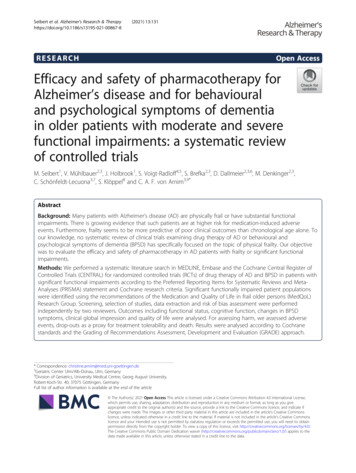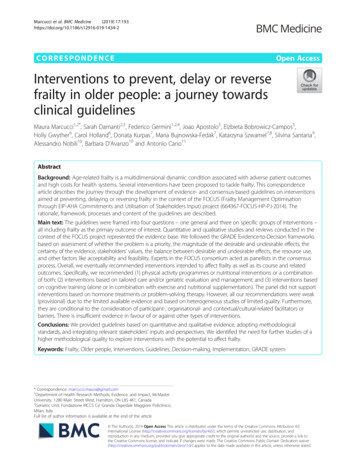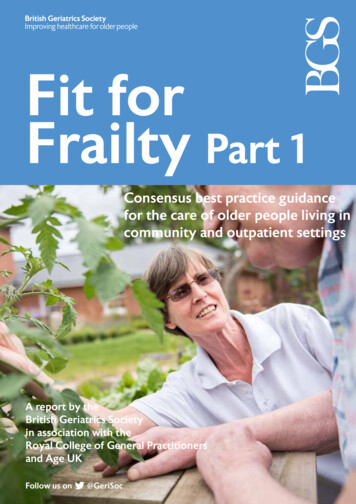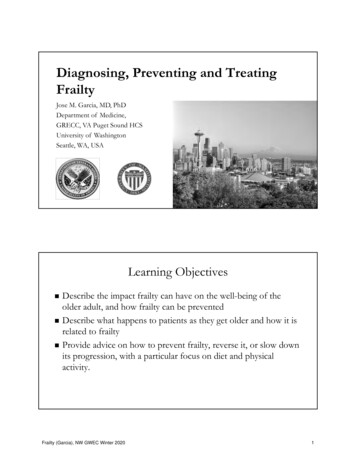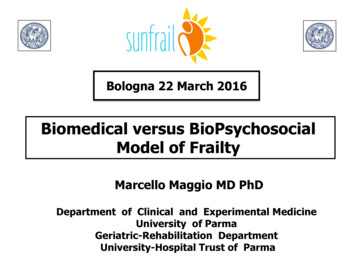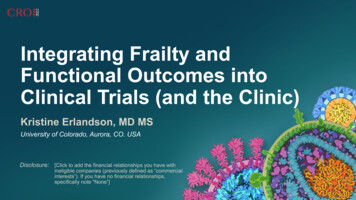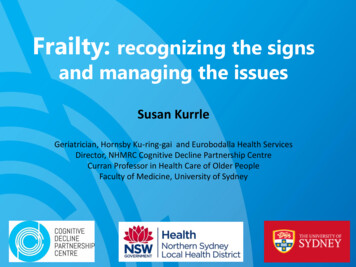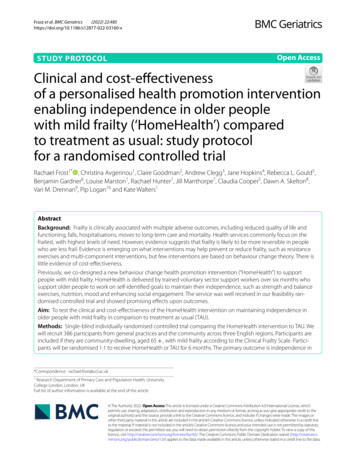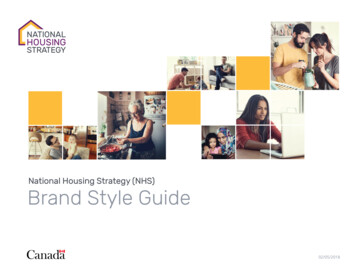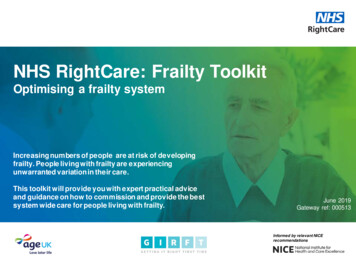
Transcription
NHS RightCare: Frailty ToolkitOptimising a frailty systemIncreasing numbers of people are at risk of developingfrailty. People living with frailty are experiencingunwarranted variation in their care.This toolkit will provide you with expert practical adviceand guidance on how to commission and provide the bestsystem wide care for people living with frailty.June 2019Gateway ref: 000513Informed by relevant NICErecommendations
SummarySystem improvementpriorities:Population segmentation,identification and stratificationSupporting people living withmild frailty and encouragingpeople to ‘age well’Supporting people living withmoderate frailtySupporting people livingwith severe frailtyReducing hospital lengthof stayFalls and fragility fracturesDelirium, dementia andcognitive disorderNHS RightCare Frailty ToolkitThis NHS RightCare system toolkit will support systems to understand the priorities in frailty careand key actions to take. It provides a way to assess and benchmark current systems to findopportunities for improvement. It is produced with reference to an expert group of stakeholdersand is supported by NICE. Wider consultation has taken place with patient representatives,clinicians, social care organisations, professional bodies and other key stakeholders.The national challenges: Increasing numbers of people are at risk of developing frailty. A person living with mild frailtyhas twice the mortality risk of a fit older person. More people living with mild, moderate or severe frailty are attending emergencydepartments, with over 4000 admissions daily for people living with frailty. Older people living with mild, moderate or severe frailty are more likely to have delayedtransfers of care. 45% of people experiencing delayed transfers of care are over 85(approximately 50% of people aged 85 and over will encounter frailty). People living with mild, moderate or severe frailty could often have their needs met best insettings outside of acute hospital care. Severe frailty often brings over four times the costs ofnon-frailty.The national NHS RightCare opportunityPersonalised careExperience of careGuidance and best practice29,000 fewer injuries due to falls in peopleaged 65 or over if CCGs achieved the rate oftheir lowest five peers.25,000 fewer long stay patients aged 85 orover if CCGs achieved the rate of their lowestfive peers.Links to other NHS RightCare productsNHS RightCare has a comprehensive frailty support offer which includes:Self-assessmentquestionnaireAdditional NHS RightCarefrailty products NHS RightCare Frailty Focus Pack: This provides each CCG in England with the mostrelevant frailty data, compared to their most similar ten CCGs. To access please contact yourlocal Delivery Partner. NHS RightCare Frailty Scenario: This provides Janet’s story of living with frailty in a suboptimal pathway compared to an optimal pathway.
SummarySystem improvementpriorities:Population segmentation,identification and stratificationSupporting people living withmild frailty and encouragingpeople to ‘age well’Supporting people living withmoderate frailtyThis NHS RightCare toolkit supports the delivery of theNHS Long Term Plan for frailty:The NHS Long Term Plan sets out an evidence-based framework of care for olderpeople with frailty to be delivered through the national Ageing Well programme.This focuses on delivering integrated personalised care in communities andaddresses the needs of older people with three inter-related service modelscentred on clearly identifiable patient cohorts:1)Community multidisciplinary teams -targets the moderate frailtypopulation10, people whose annual risk of urgent care utilisation, death andcare home admission is 3 times that of an older person of the same age who isfit. This group are considered to be the most amenable to targeted proactiveinterventions to reduce frailty progression and unwarranted secondary careutilisation.2)Urgent Community Response–crisis response and community recovery forolder people who are at risk of unwarranted stay in hospital admission andwhose needs can be met more effectively in a community setting.3)Enhanced health in care homes–for which there is not a consistent healthcare support offer across England despite care home beds outnumbering NHShospital beds by 3:1 and being an increasingly important place for end of lifecare;Supporting people livingwith severe frailtyReducing hospital lengthof stayFalls and fragility fracturesDelirium, dementia andcognitive disorderPersonalised careExperience of careGuidance and best practiceSelf-assessmentquestionnaireAdditional NHS RightCarefrailty productsThe Ageing Well programme and framework aim to support commissioners andproviders of acute and community health services, social care and the voluntarysector to work together, turning what is currently urgent care into planned care forkey groups of vulnerable older people.Professor Martin J Vernon, National Clinical Director for Older People and PersonCentred Integrated Care
NHS RightCare Frailty Toolkit:System improvement prioritiesPopulation segmentation,identification and stratificationof frailtyFalls and fragilityfracturesSupporting people living withmild frailty and encouragingpeople to ‘age well’Delirium, dementia andcognitive disorderSupporting people livingwith moderate frailtyPersonalised careSupporting people livingwith severe frailtyExperience of careReducing hospitallength of staySelf-assessmentquestionnaire
SummarySystem improvementpriorities:Population segmentation,identification and stratificationSystem improvement priority:Population segmentation, identification and stratification offrailtySupporting people living withmoderate frailtyKey areas for focus:Supporting people livingwith severe frailtyReducing hospital lengthof stayFalls and fragility fracturesDelirium, dementia andcognitive disorderPersonalised careExperience of careGuidance and best practiceSelf-assessmentquestionnaireAdditional NHS RightCarefrailty productsSystem wide recognition of the signs of frailtyEveryone in a system who could encounter people living with frailty knowswhat the signs are. This includes health and social care workers, family,carers, emergency services, and voluntary sector workers.Guidanceand bestpracticeKnow what to do when signs of frailty are foundIt is critically important that when signs of frailty are suspected that peopleknow what to do. This is important in a variety of settings, from emergencydepartments to community exercise classes to patients’ homes.Guidanceand bestpracticeStandardised way of stratifying frailtyHaving a strategy to consistently stratify frailty is key to an organisedsystem. The GP contract supports the use of a standardised approach tofrailty stratification and population segmentation. This could be donethrough the electronic frailty index (eFI).Guidanceand bestpracticeIdentify frailty and frailty riskEnsure that when appropriately trained health and care staff suspect frailty,that they can then undertake an individual frailty score to identify frailtystatus. Using tools such as the PRISMA-7 questionnaire.Guidanceand bestpracticeActions to takeSupporting people living withmild frailty and encouragingpeople to ‘age well’Segmentation, identification and stratification of the population living with frailty by needs and notage is essential. This allows use across health and social care, that can support joint priorities,and integrated and personalised care. This part of the toolkit contains support for commissionersand providers of health and social care across the system in all settings; from care homes toprimary care to hospital care.
SummarySystem improvementpriorities:Population segmentation,identification and stratificationSupporting people living withmild frailty and encouragingpeople to ‘age well’Supporting people living withmoderate frailtySystem improvement priority:Population segmentation, identification and stratification offrailtyActions to take:System widerecognition ofthe signs offrailty Have a network of ‘frailty champions’ or a ‘frailty forum’ identified, with a role inpromoting a consistent and universal awareness and understanding of frailty. Take a systematic approach to promoting the awareness and understanding offrailty with individuals, carers, families and partners in health, care, voluntarysector and wider public services. Align understanding of frailty to the Frailty Core Capabilities Framework’sDomain A, ‘Understanding, identifying and assessing frailty’.Know what todo when signsof frailty arefound Use a systematic approach to identifying which people living with frailty are mostat risk and are therefore most likely to benefit from a comprehensive geriatricassessment (CGA) – or targeting CGA to those most likely to benefit. Communicate across the system the outcome of a CGA and associated actionplan. Do you have a universal referral process? How do services refer to each other?Standardisedway ofstratifyingfrailty Use an appropriate risk stratification or population segmentation tool such as theelectronic frailty index (eFI) in accordance with the GP contract. Ensure clinical correlation of eFI results is undertaken. Consider implications of resource modelling based on stratification of frailtypopulation.Identify frailtyand frailty risk Ensure that you identify frailty as a trigger so that people are referred andsupported appropriately within the health and social care system. Do this in a way that is acceptable for older people and enables them to work inpartnership with their health professionals. Align understanding of frailty to the Frailty Core Capabilities Framework‘understanding frailty’ criteria at Tier 1 across all services.Supporting people livingwith severe frailtyReducing hospital lengthof stayFalls and fragility fracturesDelirium, dementia andcognitive disorderPersonalised careExperience of careGuidance and best practiceSelf-assessmentquestionnaireAdditional NHS RightCarefrailty productsGuidance and best practice examples
System improvementpriorities:Population segmentation,identification and stratificationSupporting people living withmild frailty and encouragingpeople to ‘age well’Supporting people living withmoderate frailtySupporting people livingwith severe frailtyReducing hospital lengthof stayFalls and fragility fracturesDelirium, dementia andcognitive disorderPersonalised careExperience of careSystem improvement priority:Supporting people living with mild frailty and encouragingpeople to ‘age well’It is important to prevent or delay the onset of mild frailty and to be proactive in supportingpeople living with or at risk of mild frailty. Rehabilitation or reablement and stopping progressionin functional ability are key objectives for this group. When people are ageing well it is importantto encourage and support people to maintain this status, especially considering that frailty startsearlier and progresses more rapidly in socio-economically deprived areas. This section of thetoolkit supports community and primary care to take preventative and proactive approaches tothe provision of frailty care.Key areas for focus:Define the local healthy lifestyle offer for: Physical activity, weightmanagement, smoking cessation and alcoholKeeping active, maintaining a healthy weight and not smoking will go a long wayto preventing or reversing the progression of frailty. Understanding the local offerfor these priorities in terms of access and capacity and demand is of keyimportance.Education and understanding of frailty (in the population as well as inhealth and social care)What is the education and training strategy around frailty for your population?How do you plan to support development of core capabilities across all three tiers,and all four domains of the Frailty Core Capabilities Framework?Guidanceand bestpracticeGuidanceand bestpracticeSupported self-managementGuidance and best practiceSelf-assessmentquestionnaireSupport for people to maintain active and healthy ageing in both physical andmental health is key for systems to reduce risk of frailty progression. This cancome through numerous modes such as exercise groups, befriending services,health navigation, and information in a variety of formats.Guidanceand bestpracticeNutritionAdditional NHS RightCarefrailty productsMaintaining a healthy weight helps people to avoid frailty and reverse the effectsof mild frailty. Being underweight can put people at risk of frailty as well as beingsignificantly overweight. Nutrition support and advice tailored to people with frailtyis key.Guidanceand bestpracticeActions to takeSummary
SummarySystem improvementpriorities:Population segmentation,identification and stratificationSupporting people living withmild frailty and encouragingpeople to ‘age well’Supporting people living withmoderate frailtySupporting people livingwith severe frailtyReducing hospital lengthof staySystem improvement priority:Supporting people living with mild frailty and encouragingpeople to ‘age well’Actions to take: Define the local offer for weight management, smoking cessation, physical activity andalcohol reduction, and how it specifically supports people at risk of or living with frailty.Define the local Define the referral process into these services.healthy Support and educate people living with, or at risk of, frailty in how to make lifestylelifestyles offeradjustments and challenge barriers a healthy lifestyle Undertake strategies such as making every contact count.Education/understandingof frailty Have a shared awareness and understanding of frailty. Align understanding of frailty to the Frailty Core Capabilities Framework’s Domain A,‘Understanding, identifying and assessing frailty’. Create a communications strategy to target the whole population about frailty.Supported selfmanagement Understand what self-management education and services are available within the localcommunity to enhance patient activation and empowerment. Ensure statutory servicescan easily make referrals and receive feedback on progress where these are lead bythird sector organisations. Have a local directory of services and support available which enables ease ofsignposting or referral for people living with frailty to the services they may find useful. Have a commissioned social prescribing service across the whole locale. Ensure strategies for routinely assessing older people's mental health, including theidentification of depression, anxiety and loneliness, together with appropriateinterventions are in place. Ensure strategies are in place for the routine identification of carers and that they areappropriately supported (linking to long term plan carers commitments).Nutrition Routine screening for risk of malnutrition across health and social services in people atrisk of developing frailty. Provide nutrition education specifically for people at risk of or living with frailty.Falls and fragility fracturesDelirium, dementia andcognitive disorderPersonalised careExperience of careGuidance and best practiceSelf-assessmentquestionnaireAdditional NHS RightCarefrailty productsGuidance and best practice examples
System improvementpriorities:Population segmentation,identification and stratificationSystem improvement priority:Supporting people living with moderate frailtySupporting people living withmild frailty and encouragingpeople to ‘age well’It is estimated that 12% of people aged 65 or over are living with moderate frailty. Key aims forthis group are to provide integrated multidisciplinary teams (MDT) to support people inrehabilitation and reablement and prevent further progression of their frailty. This part of thetoolkit should be used as a system. It is a means of supporting the management of people withmoderate frailty in the community rather than them needing to access hospital based care.Supporting people living withmoderate frailtyKey areas for focus:Supporting people livingwith severe frailtyReducing hospital lengthof stayFalls and fragility fracturesDelirium, dementia andcognitive disorderPersonalised careExperience of careGuidance and best practiceSelf-assessmentquestionnaireAdditional NHS RightCarefrailty productsMultidisciplinary team assessment of risk stratified patientsWhen it is identified that an individual is living with moderate frailty thereshould be a response from the MDT. A needs based assessment of bothphysical and mental health should be undertaken and an intervention orsignposting to be instigated as appropriate. MDT meetings should continuefor individuals on an on-going basis until frailty status stabilises orimproves, and/or until identified risks are appropriately managed.Home and community based rehabilitationHome or both out-patient and in-therapy led patient rehabilitationdepending on the needs of the individual. This facilitates the primary aim tosupport people living with moderate frailty to 'age well'. Aiming at 'step-up'care to avoid admissions, and 'step down' care to support post hospitalcare.Recognition of deteriorationIt is important to recognise when people living with moderate frailty (or anylevel of frailty) are at risk of, or have, a deteriorating frailty status. Promptresponse to deterioration can reduce the impact of increased frailtyprimarily for the individual but also for health and care systems.Guidanceand bestpracticeGuidanceand bestpracticeGuidanceand bestpracticeActions to takeSummary
SummarySystem improvementpriorities:System improvement priority:Supporting people living with moderate frailtyActions to take:MDT teamassessment ofrisk stratifiedpatients Services involved in a patient’s care are able to access and contribute to thatperson’s current Comprehensive Geriatric Assessment document. Services use experience of care feedback from patients and carers to improveservices using co-production and co-design. Map the skills required in the MDT and align workforce to skills assessment. Understand numbers of people living with frailty in the system and match MDTteam capacity to this demand. Ensure that carers are routinely identified and offered support. Ensure that mental health needs of patients and carers are assessed andspecifically addressed.Home andcommunitybasedrehabilitation Services address both the ‘routine’ and proactive management of frailty as a longterm condition and have responsive management of exacerbations and changesthat occur in common frailty syndromes. Have an up to date map or directory of all services with service leads, potentiallyrelated to frailty care and support that deliver across the health, social care andvoluntary sector, e.g., falls prevention, NHS Health check and activity groups (socialor medical related). Know what the capacity of services are including community rehabilitation andintermediate care (bed and home based).Recognition ofdeterioration Have a strategy and action plan that is adopted across the system so everyoneinvolved in frailty knows 'what to do' when deterioration of frailty status is found. People living with moderate or severe frailty have access to a patient-centred MDTreview when need changes involving all partners in care, including the individual. People living with frailty should be encouraged to review their ongoing supportneeds and personal planning when a change is noted in their support requirementseither by themselves or carers or by support staff, clinicians and key workers. All relevant commissioners and providers of services are aware of the Frailty CoreCapabilities Framework How is the framework being used or implemented in relation to services offeringsupport to people and their carers living with frailty?Population segmentation,identification and stratificationSupporting people living withmild frailty and encouragingpeople to ‘age well’Supporting people living withmoderate frailtySupporting people livingwith severe frailtyReducing hospital lengthof stayFalls and fragility fracturesDelirium, dementia andcognitive disorderPersonalised careExperience of careGuidance and best practiceSelf-assessmentquestionnaireAdditional NHS RightCarefrailty productsGuidance and best practice examples
System improvementpriorities:Population segmentation,identification and stratificationSupporting people living withmild frailty and encouragingpeople to ‘age well’Supporting people living withmoderate frailtySupporting people livingwith severe frailtyReducing hospital lengthof stayFalls and fragility fracturesDelirium, dementia andcognitive disorderPersonalised careExperience of careGuidance and best practiceSelf-assessmentquestionnaireAdditional NHS RightCarefrailty productsSystem improvement priority:Supporting people living with severe frailtyIndications from GP contract data suggest that 3% of over 65 year olds are living with severefrailty. Severe frailty has a significant impact on individuals. Support and prevention ofdeterioration are key priorities. This section of the toolkit is important for the whole system toconsider, however a specific focus is on social care. Some of the priorities below can also beadopted to support people with progressing moderate frailty.Key areas for focus:Training and capabilities of social care staffPeople living with severe frailty are more likely to be supported in carehomes. It is therefore important that staff in care homes have capabilitiesto support people living with severe frailty.Management of urgent care situationsA significant amount of admissions to hospital from care homes areavoidable. People from socioeconomically deprived areas are more likelyto be admitted to hospital from care homes, and could potentially beavoided if suitable alternatives are in place.Guidanceand bestpracticeGuidanceand bestpracticeEnhanced health in care homesUsing work from the new models of care programme it is important to focuson strategies that will enhance health care in care homes for people livingwith severe frailty.Guidanceand bestpracticeEnd of life carePeople with severe frailty can be moving towards the end of their life.When an individual is identified as having severe frailty their preferencesand needs around their end of life care should be fully understood.Guidanceand bestpracticeActions to takeSummary
SummarySystem improvementpriorities:Population segmentation,identification and stratificationSupporting people living withmild frailty and encouragingpeople to ‘age well’Supporting people living withmoderate frailtySupporting people livingwith severe frailtyReducing hospital lengthof stayFalls and fragility fracturesDelirium, dementia andcognitive disorderSystem improvement priority:Supporting people living with severe frailtyActions to take: Have a shared awareness and understanding of frailty. Have an approach of managing frailty as a long term condition embedded across theTraining andsystem.capabilities for All relevant commissioners and providers of services should be aware of the Frailty Corewhole healthCapabilities Framework.and social How is the framework being used or implemented in relation to services offering supportcareto people and their carers living with frailty?workforce Frailty workforce development plans are linked to education and skills for dementia, endof life care skills and any other skills frameworks that are relevant.Management Know how many people with moderate or severe frailty have had planned or unplannedhospital admissions in the last year. Look for any general trends or patterns of activity.of urgent care Have a recognised rapid or crisis response service.situationsEnhancedhealth in carehomes Consult the enhanced health in care homes framework to guide improvements. Are the following principles and conditions present: person-centred change, coproduction, quality and leadership? Map workforce across the area, ensuring innovative roles and those covered by ‘newmodels of care’ are captured with a focus on frailty services. Ensure strategies to routinely identify, assess and manage mental health needs areinstigated.End of lifecare Have a baseline of preferred place of death recorded. Services and staff are equipped to support people to undertake or update an advancecare plan in a timely manner and ensure that this is known to the family and carers aswell as held by all agencies the person engages with. Staff working with people with frailty are confident to recognise that a person isapproaching the end of their life and act on this understanding. Staff working with people with frailty are confident in recognising that a person isapproaching the end of their life and feel equipped to engage effectively with patients andcarers to discuss end of life care. If not, are quality improvement plans in place to address this?Personalised careExperience of careGuidance and best practiceSelf-assessmentquestionnaireAdditional NHS RightCarefrailty productsGuidance and best practice examples
System improvementpriorities:Population segmentation,identification and stratificationSupporting people living withmild frailty and encouragingpeople to ‘age well’Supporting people living withmoderate frailtySupporting people livingwith severe frailtySystem improvement priority:Reducing hospital length of stayOlder people are more likely to be admitted following an emergency department contact. Ifadmitted it is well understood that people should be in hospital for the shortest amount of time.Reducing hospital length of stay should be seen as a system wide issue, starting in thecommunity and primary care and supporting people here so they do not need hospital. This isalso the case in supporting people living with frailty when they are medically fit for discharge butrequire rehabilitation. Considering priorities in specific settings and at interfaces between thesesettings is of equal importance.Key areas for focus:Crisis and rapid responseReducing hospital lengthof stayThese services aim to anticipate or support people living with frailty in crisis.Services have been established that have significantly reduced emergencydepartment admissions due to common frailty syndromes such as urinary tractinfections and falls.Falls and fragility fracturesFirst 24 hoursDelirium, dementia andcognitive disorderAppropriate management in the first 24 hours of admission is crucial for peopleliving with frailty. Optimal care should be established which includes considerationof whether community or primary care options would be more appropriate.Personalised careEffective rehabilitationExperience of careIf admitted it is essential that effective rehabilitation is commenced at the earliestopportunity to decrease the impact of deconditioning as an inpatient. Utilising theskills of the MDT, especially allied health professionals, is key to this.Guidance and best practiceTransfer of care to a new care settingSelf-assessmentquestionnaireHow care is transferred from hospital to other settings is important. Optimising thiskey interface within the system will provide integrated support for patients whilstsupporting efficiency in health and care services.Coordination of care through sharing informationAdditional NHS RightCarefrailty productsKnowing an individual is living with frailty, knowing individual choices, knowingwhat health and care input individuals with frailty are receiving is important for thewhole system.Guidanceand bestpracticeGuidanceand bestpracticeGuidanceand bestpracticeGuidanceand bestpracticeGuidanceand bestpracticeActions to takeSummary
SummarySystem improvementpriorities:System improvement priority:Reducing hospital length of stayActions to take:Population segmentation,identification and stratificationSupporting people living withmild frailty and encouragingpeople to ‘age well’Crisis andrapid responseSupporting people living withmoderate frailtySupporting people livingwith severe frailtyReducing hospital lengthof stayFirst 24 hoursFalls and fragility fracturesDelirium, dementia andcognitive disorderPersonalised careEffectiverehabilitationExperience of careGuidance and best practiceSelf-assessmentquestionnaireAdditional NHS RightCarefrailty productsTransfer ofcare to a newcare setting Identify how many people with moderate or severe frailty have fallen in the last year,or have fallen resulting in fracture and how this associates with the input of fallsservices. Have a recognised crisis or rapid response service. Have a specific strategy to manage crisis situations on a needs basis according tofrailty stratification. Use NEWS2 to recognise acute illness and onset of delirium. Know if frailty identification is undertaken in urgent care settings and how thisinformation is shared. Know how many people with moderate or severe frailty have had planned orunplanned hospital admissions in the last year. Are there any general trends orpatterns of activity you have identified? All services involved in patients’ care should be able to access and contribute to thatperson’s current Comprehensive Geriatric Assessment document. All hospital based staff recognise responsibility for supporting people with frailty tomaintain usual activity levels. The whole team supports the rehabilitation goals and preferences of people livingwith frailty whilst an in-patient. Communication of usual functional levels and updated goals should occur betweenhospital and community. Have seamless communication between hospitals and the new care setting. Have a shared and integrated system approach to supporting transfer of care. Know what the capacity of services are including community rehabilitation andintermediate care (bed and home based).Coordination of Ensure all the services working with people living with frailty in your area haveaccess to the enhanced summary care record.care through Staff of all services should routinely access the enhanced summary care record (orsharingequivalent) to support patient care, with particular reference to frailty identification.inform
Support for people to maintain active and healthy ageing in both physical and mental health is key for systems to reduce risk of frailty progression. This can come through numerous modes such as exercise groups, befriending services, health navigation, and information in a variety of formats. Nutrition
